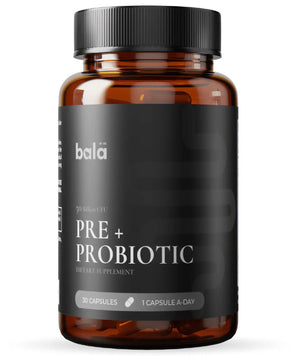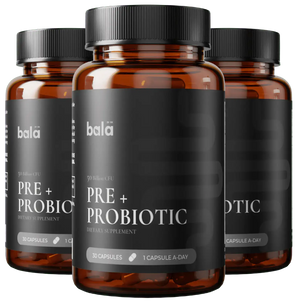Table of Contents
Introduction
Did you know that bread, often viewed as the enemy in weight loss journeys, can actually be a valuable part of a healthy diet? Surprisingly, studies show that certain types of bread can aid in weight management, thanks to their fiber content and nutritional benefits. If you're like many of us, you might have wrestled with questions about bread and weight loss: Is it possible to enjoy bread while still shedding pounds? Are there specific types of bread that are better for weight loss?
In this post, we will explore the intricacies of choosing the best bread for weight loss, considering aspects such as nutritional content, fiber, and how different breads affect our gut health. At Bala Health, we understand the importance of making informed dietary choices that are backed by science, which is why we are committed to providing clean, functional, and science-backed probiotics. Our goal is to help you feel better from the inside out.
We’ll delve into the types of bread that align well with weight loss goals, how to identify healthier options, and practical tips on incorporating bread into a balanced diet. By the end of this article, you’ll have a clearer understanding of how to choose the right bread for your weight-loss journey, without sacrificing flavor or satisfaction.
Why Focus on Bread?
Bread has been a dietary staple for centuries, but its reputation has suffered in recent years due to low-carb diets and misconceptions about carbohydrates. However, not all breads are created equal. Whole grain and other nutrient-dense breads can offer significant health benefits, including supporting gut health—a topic we are passionate about at Bala Health.
Are you tired of the confusion surrounding bread choices? Do you want to know what specific types of bread can help you meet your weight-loss goals? If the answer is yes, keep reading as we uncover the best options to consider.
Understanding Bread Types: What to Look For
When selecting bread, it is essential to know what makes some types healthier than others. Here are the key factors to consider:
1. Whole Grains vs. Refined Grains
Whole Grains: Bread made from whole grains retains all parts of the grain—the bran, germ, and endosperm. This means it is higher in fiber, vitamins, and minerals. Whole grain breads can help maintain stable blood sugar levels, promote satiety, and support digestive health.
Refined Grains: These breads are made from flour that has been stripped of the bran and germ. This process removes many nutrients and fiber, making refined grain breads less beneficial for weight loss.
2. Fiber Content
Fiber is a crucial component of a weight-loss-friendly diet. It aids digestion, keeps you feeling full longer, and can help regulate blood sugar levels. Look for breads that offer at least 3 grams of fiber per slice. Higher fiber content can enhance the feeling of fullness, which is essential when trying to reduce overall calorie intake.
3. Added Sugars
Many breads contain added sugars, which can contribute to weight gain and hinder weight-loss efforts. Always check the ingredient list and nutrition facts label, aiming for breads with less than 1 gram of added sugar per slice.
4. Ingredients Matter
Opt for breads with simple, recognizable ingredients. Avoid those containing hydrogenated oils, high fructose corn syrup, or artificial additives.
5. Nutritional Add-Ons
Some breads include seeds, nuts, or other nutritious ingredients that can enhance their health benefits. For example, flaxseed or chia seed breads can provide additional omega-3 fatty acids, protein, and fiber.
The Best Breads for Weight Loss
Here are our top recommendations for the best breads to include in your weight-loss journey:
1. Sprouted Whole Grain Bread
Sprouted bread is made from whole grains that have begun to sprout, increasing nutrient availability and digestibility. Sprouting can enhance the bread’s fiber and protein content, making it more filling and nutritious.
- Example: Ezekiel 4:9 Sprouted Whole Grain Bread
- Nutritional Benefits: High in protein and fiber, lower in carbohydrates.
2. Sourdough Bread
Sourdough is made through a fermentation process that not only gives it a unique flavor but also makes it easier to digest. The fermentation process can lower the bread's glycemic index, helping to stabilize blood sugar levels.
- Example: Whole Wheat Sourdough
- Nutritional Benefits: Contains probiotics that can benefit gut health, and lower blood sugar spikes.
3. 100% Whole Wheat Bread
This type of bread is made from whole wheat flour, ensuring you receive all the nutrients and fiber found in the grain. When shopping, look for “100% whole wheat” on the label.
- Example: Nature's Own 100% Whole Wheat
- Nutritional Benefits: Good source of fiber and essential nutrients.
4. Oat Bread
Oat bread is made primarily from whole grain oats and can be a delicious, nutritious option. Oats are known for their heart health benefits and can aid in digestion.
- Example: Whole Grain Oat Bread
- Nutritional Benefits: High in fiber and beneficial nutrients like magnesium and iron.
5. Flax Bread
Flax seeds are packed with omega-3 fatty acids and fiber, making flax bread a nutritious option.
- Example: Ezekiel Sprouted Whole-Grain Flax Bread
- Nutritional Benefits: High in fiber and healthy fats.
6. Rye Bread
Rye bread, especially when made from 100% whole-grain sprouted rye flour, can be more filling than wheat bread and may help regulate blood sugar levels.
- Example: 100% Sprouted Rye Bread
- Nutritional Benefits: High in fiber, potentially lower in calories.
7. Gluten-Free Bread
For those with gluten sensitivity or celiac disease, gluten-free breads made from whole food ingredients can be a healthy choice. Just be cautious of those high in added sugars.
- Example: Almond Flour Bread
- Nutritional Benefits: Lower in carbs, higher in healthy fats and protein.
How to Choose a Healthy Bread
Now that we’ve identified the best types of bread, here are some practical tips for selecting healthy options:
- Read Labels Carefully: Always check that the first ingredient is a whole grain, and be wary of misleading terms like "multigrain," which may not be whole grain.
- Prioritize Fiber: Choose breads with at least 3 grams of fiber per slice to help keep you full.
- Watch for Added Sugars: Limit your bread options to those with minimal added sugars.
- Consider Portion Size: Even healthy bread should be consumed in moderation. Aim for one slice per meal when possible.
- Experiment with Whole Foods: If you're feeling adventurous, consider baking your bread! This way, you can control the ingredients and ensure a healthy outcome.
Incorporating Bread into Your Diet
It’s all about balance! Here are a few creative ways to include bread in your meals while supporting your weight loss goals:
- Open-Faced Sandwiches: Instead of using two slices of bread, opt for one and pile on the veggies and lean proteins.
- Toast Toppings: Top whole grain toast with avocado, nut butter, or hummus for a filling snack.
- Bread with Soups and Salads: Enjoy a slice of healthy bread alongside a hearty soup or salad to enhance your meal’s fiber content.
- Healthy Breakfast Choices: Use sprouted grain or oat bread for breakfast toast topped with eggs or Greek yogurt.
The Role of Probiotics in Gut Health and Weight Management
At Bala Health, we emphasize the importance of gut health for overall wellness. The gut microbiome plays a crucial role in digestion, nutrient absorption, and even weight management. By choosing the right bread, you can support your gut health while enjoying your meals.
Our flagship probiotic is designed to support digestive health and overall well-being. Integrating a clean, science-backed probiotic into your daily routine can complement your efforts in maintaining a balanced diet and promoting gut health.
- Start your journey to better gut health with our clinically-backed probiotic now! Shop now.
Conclusion
In conclusion, bread does not have to be a forbidden food on your weight-loss journey. By choosing the right types of bread—such as sprouted whole grain, sourdough, and oat bread—you can enjoy its delicious taste while reaping the benefits of fiber and essential nutrients.
At Bala Health, we believe in empowering our community with knowledge about gut health and nutrition. By making informed choices about the foods we eat, including bread, we can support our weight-loss goals and overall well-being.
Are you ready to take control of your health journey? Find your personalized gut-health roadmap by taking our 3-minute Weight-Loss Quiz! Start the quiz.
Remember, bread can be part of a healthy lifestyle when enjoyed mindfully. By incorporating our clean, functional probiotics into your routine, you can further support your journey toward wellness.
FAQ
1. Can I eat bread every day if I'm trying to lose weight?
Yes, you can include bread in your daily diet while trying to lose weight. Just opt for healthier options like whole grain or sprouted breads and control your portion sizes.
2. What type of bread is best for weight loss?
The best breads for weight loss include sprouted whole grain, sourdough, and oat bread, as they are typically higher in fiber and nutrients.
3. How much bread should I eat daily?
Aim for one slice of bread per meal, and incorporate it as part of a balanced diet rich in fruits, vegetables, and lean proteins.
4. Are gluten-free breads healthier?
Not necessarily. While gluten-free breads are essential for those with gluten sensitivities, they can also be high in added sugars and low in fiber. Always check the ingredients.
5. How can probiotics help with weight loss?
Probiotics support gut health, which can improve digestion and nutrient absorption, potentially aiding in weight management. Consider integrating our clean, science-backed probiotic into your routine for added digestive support. Shop now.
By choosing the right types of bread and incorporating healthy practices, you can enjoy the benefits of bread while moving toward your weight-loss goals. Together, let's embrace better health from the inside out!






